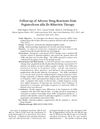
Search
for
Sort by
Research
180-210 / 446 results

research The Pharmaceutical Market as Reflected by Patents
The document shows the state of pharmaceutical patents as of 1999, focusing on treatments for various diseases.

research Male Pattern Baldness: Causes, Treatments, and Future Prospects
Most American men experience hair loss by age 50, with limited effective treatments available and new options not expected soon.

research Drugs Affecting Blood Coagulation, Fibrinolysis, and Hemostasis
Some blood-thinning medications can increase the risk of bleeding, and certain factors like genetics and other health conditions affect their safety and effectiveness.

research Use of Chemotherapy During Human Pregnancy
Chemotherapy in the first trimester of pregnancy is risky, but in the second and third trimesters, it's generally safe with careful drug selection and timing.

research The Rotterdam Study: 2018 Update on Objectives, Design, and Main Results
The Rotterdam Study updated findings on elderly health, focusing on heart disease, genetics, lifestyle effects, and disease understanding.

research The Rotterdam Study: 2016 Objectives and Design Update
The Rotterdam Study found risk factors for elderly diseases, links between lifestyle and genetics with health conditions, and aimed to explore new areas like DNA methylation and sensory input effects on brain function.

research The Rotterdam Study: 2014 Objectives and Design Update
The Rotterdam Study aims to understand disease causes in the elderly and has found new risk factors and genetic influences on various conditions.

research SRD5A3 Is Required for Converting Polyprenol to Dolichol and Is Mutated in a Congenital Glycosylation Disorder
Mutations in the SRD5A3 gene cause a new type of glycosylation disorder by blocking the production of a molecule necessary for protein glycosylation.

research The North American Menopause Society Recommendations for Clinical Care of Midlife Women
The NAMS 2014 recommendations guide healthcare providers on treating health issues in midlife women, emphasizing individualized care and informed decision-making.

research The Current Landscape for Direct-to-Consumer Genetic Testing: Legal, Ethical, and Policy Issues
The document concludes that the fast-growing direct-to-consumer genetic testing market lacks sufficient regulation, posing risks to consumers due to questionable test quality and accuracy.

research The Rotterdam Study: 2010 Objectives and Design Update
The Rotterdam Study aims to understand various diseases in older adults.

research British Association of Dermatologists’ Guidelines for the Management of Alopecia Areata 2012
Guidelines suggest various treatments for alopecia areata, but leaving it untreated is also an option as 80% cases may recover on their own.

research Hormesis And Medicine: Biphasic Dose-Response Relationship
Low doses of some substances can be beneficial, while high doses can be harmful or toxic.

research Male Androgenetic Alopecia
Hair loss in men treated best with early medication or transplant, new treatments researched.

research Alopecia Areata Update
Alopecia Areata is an autoimmune condition often starting before age 20, with varied treatment success and a need for personalized treatment plans.

research Alopecia Areata: An Evidence-Based Treatment Update
Some treatments, like corticosteroids and sensitizing agents, can help with alopecia areata, but more high-quality research is needed.

research Mechanisms of Disease: Selective Inhibition of 11β-Hydroxysteroid Dehydrogenase Type 1 as a Novel Treatment for Metabolic Syndrome
Blocking the enzyme 11β-HSD1 might help treat obesity and metabolic issues.

research Alopecia Areata: An Update
The document concludes that alopecia areata is an autoimmune disease without a definitive cure, but treatments like corticosteroids are commonly used.

research Keratosis Follicularis Spinulosa Decalvans
KFSD is a rare condition causing scarring hair loss, with no effective treatment known at the time of the report.

research 5α-Reduced Glucocorticoids: A Story of Natural Selection
Natural 5α-reduced glucocorticoids might be anti-inflammatory with fewer side effects than current options.

research Hair Darkening in Porphyria Cutanea Tarda
Two patients with porphyria cutanea tarda experienced their grey hair turning dark again.

research Bimatoprost Versus Mometasone Furoate in the Treatment of Scalp Alopecia Areata: A Pilot Study
Bimatoprost was found to be safer and more effective than mometasone furoate for treating scalp hair loss.

research Madarosis: A Marker of Many Maladies
Losing eyelashes or eyebrows can be a sign of many different health problems and needs a careful approach to treat effectively.

research Topical and Intralesional Therapies for Alopecia Areata
No treatments fully cure or prevent alopecia areata; some help but have side effects or need more research.

research Efficacy and Side Effects of Drugs Commonly Used for the Treatment of Lower Urinary Tract Symptoms Associated With Benign Prostatic Hyperplasia
Different drugs for prostate-related urinary symptoms work but have various side effects, and treatment should be tailored to the individual.

research Follow-Up of Adverse Drug Reactions from Peginterferon Alfa-2b—Ribavirin Therapy
Peginterferon alfa-2b and ribavirin therapy for hepatitis C can cause serious side effects, some different from those reported in clinical trials.

research What Does Acne Genetics Teach Us About Disease Pathogenesis?
Acne is significantly influenced by genetics, and understanding its genetic basis could lead to better, targeted treatments.

research A Review of Hand-Held, Home-Use Cosmetic Laser and Light Devices
Home-use cosmetic laser and light devices show modest results for hair removal and acne treatment, but more research is needed for confirmation.

research An Update on Drug-Induced Pigmentation
Some drugs can cause skin and hair color changes, often reversible when the drug is stopped.